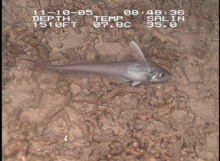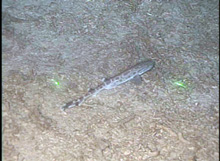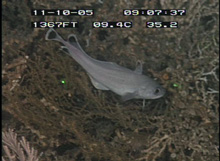
Figure 1: A rattail fish. Rattails (family Macrouridae) appear to have a predictable association with Lophelia coral reefs. Click image for larger view and image credit.
Deep Coral Fish
November 11, 2005
Grant Gilmore, Ph.D.
Fish Ecologist, Senior Research Scientist
Estuarine Coastal and Ocean Science, Inc.
![]() View
video footage from the Johnson-Sea-Link of the ocean sunfish Mola
mola swimming over the top of a Lophelia coral reef. (Quicktime, 1.2 Mb.)
View
video footage from the Johnson-Sea-Link of the ocean sunfish Mola
mola swimming over the top of a Lophelia coral reef. (Quicktime, 1.2 Mb.)
![]() View
video footage of scientist observing the interaction between a golden
crab and an roughtail catshark. (Quicktime, 612 Kb.)
View
video footage of scientist observing the interaction between a golden
crab and an roughtail catshark. (Quicktime, 612 Kb.)
![]() View
video footage of A rattail, codling, and roughtail catsharks. (Quicktime,
892 Kb.)
View
video footage of A rattail, codling, and roughtail catsharks. (Quicktime,
892 Kb.)
I am an ichthyologist, so fish are my primary interest, but one cannot understand the life history and ecology of fish without having interest in the world in which they live. Ocean currents, temperature, light, and sound are as important as food and habitat. So when I was asked to accompany coral, crustacean, sipunculid (a type of small marine worm), and algae specialists, in addition to geologists, on an expedition to the bottom of the sea, I jumped at the opportunity to give me a greater understanding of the ecology and relationships of deep reef fish and the ecosystem on which they depend.
I was in the Johnson-Sea-Link sphere for a dive on a beautiful Lophelia coral reef located 40 miles east of Cape Canaveral, Florida, where they launch earth people into space. We were launching earth people into inner space, the deep sea. On this dive we saw the highest concentration of healthy living Lophelia coral we have observed so far on this expedition. As a fish biologist, I was pleased to report that we also saw the highest density of fish and fish species observed so far.

Figure 2: The ocean sunfish Mola Mola swimming over the top of a Lophelia coral reef. Sunfish appear to have at least an ephemeral association with Lophelia coral pinnacles, as they have been seen in these locations numerous times by previous researchers. Click image for larger view and image credit.
Just before we reached the bottom, we entered a turbid layer of water that contained hundreds of minute fish larvae, bioluminescent lanternfish, hatchetfish and larval eels. We landed on the bottom at a depth of 1463 ft, a sand bottom with few dead coral fragments. On our way up a coral-covered slope we saw many slimeheads and rattails (Figure 1) hovering above the coral heads until our intense submarine lights surrounded them with an artificial halo. They immediately submerged their little heads and large sensitive eyes into the shadows of the dense fields of coral.
Once we reached the top of the peak, we were in for a big surprise. Submersible Pilot Don Liberatore and I were ambushed by a huge ocean sunfish, a Mola Mola that crept up behind the submarine and popped out in front of us as big as a billboard (Figure 2). Molas are impressive fish that do not resemble fish as much as they do a large square piece of grey blotched concrete with peculiar paddle-like dorsal and anal fins that wave back and forth, no tail, and a minute mouth for capturing or cropping invertebrates in the water column (or on substrates, pers. obs). This huge creature led us out off the pinnacle as we filmed it. We decided we had better return to the coral reef as our dive time is always limited due to submersible battery power.

Figure 3: A roughtail catshark, about 10 inches long. This is one of many catsharks observed on the bottom at the foot of the Lophelia reef pinnacle. Click image for larger view and image credit.

Figure 4: A codling, Limonema spp., apparently an intimate associate of Lophelia coral habitat. Click image for larger view and image credit.
We turned the sub around and jumped off a cliff on the backside of the reef and the sub gently sailed 200 ft to the bottom of a clay pit. Here we landed in a concentration of Lilliputian catsharks, the roughtail catshark, Galeus area (Figure 3). Why were so many here in this one spot? This looked like a social aggregation of some sort. Catsharks, like other sharks, are internally fertilized when they mate and typically segregate by sex until mating. Was this a mating aggregation? Catsharks also lay eggs on the bottom of the ocean where they hatch some days after deposition. No eggs were observed on the bottom. Some sharks were swimming in the water column while others were laying side by side on the bottom. What were they doing? Golden crabs were also seen here. We actually filmed a huge golden crab climbing over a catshark resting on the bottom. We attempted to capture a shark with the suction device, but he was too fast for us. We did manage to capture an underworld windowpane skate, Fenestraja plutonia, for later study.
They called us to the surface just as we were attempting to suction a fish from its burrow. The fish appeared to be a new addition to the coral reef fauna. Since we did not capture it on film or in hand, this fish will have to await future inner space expeditions to this site in the deep sea just east of our spaceport to the stars.
Sign up for the Ocean Explorer E-mail Update List.
























